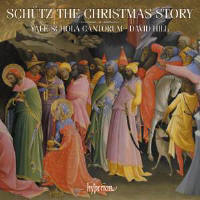Texte paru dans: / Appeared in: Hyperion |
|
|
Reviewer: J.
F. Weber
The Christmas Story (as it is
billed on the cover, though it is sung in German) is filled out with six
shorter works that belong to the season. Hans-Christoph Rademann (Fanfare
38:4) included five similar fillers with the main work, but duplicated only
SWV 456 and 468 among these, and Jean Tubéry (40:5) also included these two
on his disc. Louis Devos (10:3) added three fillers, including SWV 384 and
385. So David Hill’s well-filled Schütz Christmas program has an advantage.
Already this is the fifth CD that Hill has made for Hyperion since his
arrival in New Haven in 2013. His first, an unfamiliar Palestrina Mass
(41:6), was an augury of things to come. The student singers and players are
remarkably fine. Tenor James Reese is an excellent Evangelist in the main
work. I had to compare him directly with Rademann’s tenor (Georg Poplutz)
and Adam Riis in Paul Hillier’s version (33:5) to confirm his superb
execution of the role. The rest of the soloists and the ensemble as a whole
demonstrate the remarkable achievement that Hill has wrought at Yale. He did
not found the Schola Cantorum, for it dates to 2003 and has worked under
many directors. But a cursory glance at previous issues in the Fanfare
Archive indicates that Hill has raised the Schola to a new level of
excellence. Hill has the largest ensemble of the three issues. Rademann has a smaller chorus but a similar instrumental group, while Hillier has fewer members of both ensembles than either. Yet the Yale singers are so light, flexible, and youthful that they hardly sound like a larger group. All three versions of the main work are excellent, so the balance of the program may influence a buyer’s choice. This well-filled disc does have competition from Hillier’s coupling, the even more generous filler, the Resurrection Story, which matched an earlier pairing by Frieder Bernius (14:4). Hill’s programming is nicely calculated, the main work climactic, the other six selections alternating the longer Latin-texted pieces with the German motets. Ave Maria is one of the Kleine Geistliche Konzerte II, nicely done by Ludger Rémy (42:1), while the three German-texted pieces (SWV 384, 385, and 395) are included in Geistliche Chormusik, the most often recorded of the published books, the superb opening entry in Rademann’s complete set (31:1). The early Hodie Christus natus est, recorded half a dozen times, and the much-recorded Latin Magnificat have both appeared recently only from Rademann, as noted above. The detailed notes on each work were written by Harry Haskell, an authoritative figure in New Haven. Rademann has a fine entry in his complete set and Hillier’s group of the composer’s six major works (on four CDs) is notable, but David Hill can match the quality of both. Recommended.
| |
|
|
|
|
|
|
|
Cliquez l'un ou l'autre
bouton pour découvrir bien d'autres critiques de CD |
|




